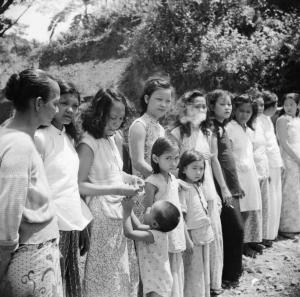Comfort Women during World War II

The goal of the lesson is to show the difficulties that the “comfort women” faced from World War II through today. By the end of the lesson, students should be able to explain the oppression that comfort women experienced and show how society played a role. A question to ask students is “why now” --comfort women began coming forward to share their stories in the 1990s after society had forcibly silenced them for decades. As this is a difficult subject, the teacher should emphasize that it is ok if students may be feeling different emotions and that practicing empathy is important. This lesson is broken up into multiple parts to allow for all learners to practice empathy and understand the role different societies played in oppressing and suppressing comfort women and their stories.
Content warning: sexual violence
Guiding Question: What about society has changed to bring the idea of justice for “comfort women” after being forgotten for almost 50 years?
Supporting Questions:
- Which women were selected to be comfort women?
- How did their role as comfort women affect them during and after World War II?
- Why were comfort women’s stories left out of the narrative of WWII and post-WWII?
- Why did some comfort women receive justice for what happened to them while others did not?
1.5 hours recommended
Students will learn about the details of comfort women throughout Asia so they can understand the different ways/avenues that comfort women experienced oppression during and after WWII.
They will know they’ve got it when they can participate in a discussion on why some histories are forgotten.
The students should have knowledge of Japan in WWII and its influence in Asia.
Materials:
- PowerPoint with background information
- 3 or 6 testimonies/statements of comfort women (taken from list below)
- The Comfort Women: Fight for Justice and Honor (video) on the present movement (optional)
Primary and Secondary Sources:
Warm Up:
Start by giving students a content warning. This lesson plans deals with sexual violence.
What is in a name? How does a name determine our perception of someone or an object? Using images of objects of both positive and negative things—examples could include poison ivy, rattlesnake, rainbow sprinkles, baby animals—begin a discussion on how the use of words and names can greatly impact we perceive others or objects. This discussion should then move to the phrase “comfort women.” Ask the students what this phrase implies and what they think comfort women’s roles were during World War II.
Activity 1:
Share the PowerPoint on comfort women to provide background information to students.
Activity 2:
- After sharing the PowerPoint, split the students into six different groups.
- Ask each group to read a different comfort woman’s story OR have multiple groups read the same testimony (taken from Primary and Secondary Source list).
- Ask the students to read independently and complete a graphic organizer.
- Once the students have independently completed their graphic organizer, have the students share their answers in their groups.
Explain to the students that they will be having a class discussion where they will use their assigned testimony from comfort women as evidence. Questions for discussion include:
- Why were comfort women selected and used during war?
- How did their role as comfort women affect them during and after WWII?
- Why were comfort women’s stories left out of the narrative of WWII and post-WWII?
- Why did some comfort women receive justice for what happened to them while others did not?
- What do you think has changed since WWII that allows some comfort women to receive justice after being forgotten for decades?
Activity 3 (optional):
Show the video titled The Comfort Women: Fight for Justice and Honor (video). Tell students this video is from 2017 and more has been done since its publication. This video shows more recent activity related to Korea’s recognition of the oppression of comfort women as well as recent activity in the United States. From minutes 12 - 19, it becomes Yong Soo Lee’s testimony
Summary and Informed Action:
For the wrap up, have the students individually create an exit ticket that asks them to decide what these women should be called and why. Does the name “comfort women” fit? Or is there a better name?
Additional opportunity:
- Students can write to a local or congressional representative urging them to make a statement on comfort women and their legacy.
- Students can conduct their own research on the more recent events involving comfort women and Japanese recognition of their stories.
Modifications:
- Some of the testimonies can be difficult to read so a glossary could be beneficial for differentiation.
- Another possibility is to use the artwork in place of the testimonies and allow the students to use those images to piece together the experiences of the women and how they felt.
- Lastly, in place of the written testimony, teacher can show the video of Yong Soo Lee’s testimony (begins at minute 12).
Learning Standards:
D2.His.4.9-12. Analyze complex and interacting factors that influenced the perspectives of people during different historical eras.
D2.His.5.9-12. Analyze how historical contexts shaped and continue to shape people’s perspectives.
